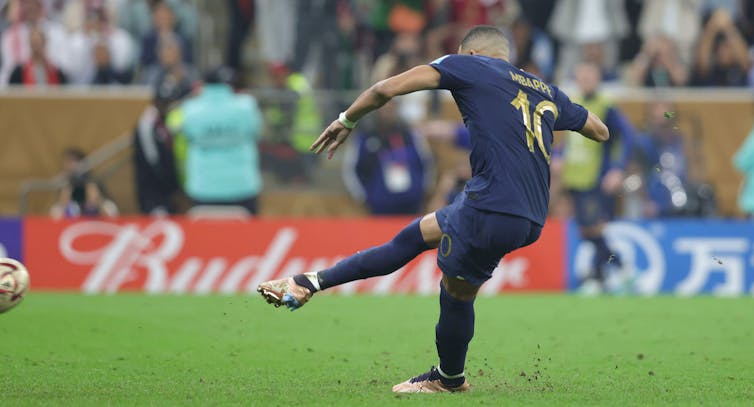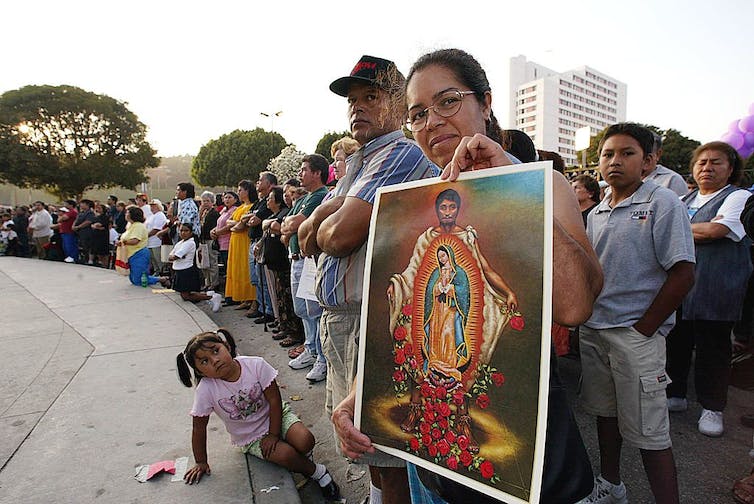EA Sports’ Fifa football videogame series is arguably the most successful sports gaming franchise of all time. Since its debut in 1993, it has sold over 260 million copies across 29 iterations. This position was reaffirmed in 2022, with its latest instalment, Fifa23, reported as the UK’s highest selling videogame at Christmas.
In Fifa games – soon to be rebranded as EA Sports FC – gamers are able to simulate playing as, and against, their idols, with state-of-the-art graphics and individual player attributes that are assigned to match the abilities of real-world players. It is, as the franchise’s website puts it, the “most true-to-life experience of the world’s game” without physically kicking a ball about.
Our recent study into the Fifa20 game shows that physical play wasn’t the only thing the game replicated. It also reproduced – within its very coding – the racial stereotypes that are deeply embedded within the sport.

dpa picture alliance / Alamy Stock Photo
How digital players are ranked
In Fifa, gamers choose to play as almost any professional club or national team. These are digital versions of current, real-world squads, which include players from Paris St Germain’s Kylian Mbappé to Chelsea’s Samantha Kerr. Each player’s performance level is determined by a score of 1 to 99, assigned to them by the game’s data collection team, which determines their ranking within the game.
This score is an aggregate value of the scores the player gets on 29 different competencies. These range from the player’s ability to perform “long shots” and how high they can “jump” to their “strength” and “aggression”. And the scores are based on the data collection team’s interpretation of the real-world player’s competencies.
In 2020, we collated data from what was, at the time, the latest instalment in the Fifa series: Fifa20. We examined the aggregate scores assigned to the white and black digital players who were ranked as the game’s top 100 players. We found that when it came to competencies that the game itself had classified as “physical”, black players scored more highly in almost all cases compared to white players.
This included in relation to their sprint speed (79.15 to 71.63), ability to jump (78.19 to 71.24), physical strength (76.69 to 72.0), balance (76.69 to 75.45) and levels of aggression (74.04 to 71.5).
When it came to attributes that the game classified as relating to a player’s technical or cognitive ability, the reverse was apparent. White digital players’ scores were, on average, higher than black players in almost all categories.
White players had higher average scores for their ability to cross a ball (72.29 to 71.35), to accurately take free kicks (67.98 to 64.53) and to accurately curve a pass (74.53 to 71.04). They scored more highly for composure (85.4 to 84.62) too.
Put simply, our study found that the aggregate scores for the digital players’ sporting attributes directly correlated with the racial stereotypes associated with black and white footballers in real life.
The “natural black athlete” stereotype
Sociological studies on racism in sports commentary have consistently found that football match commentators overwhelming “see” and praise white athletes for their intelligence and black players for their inherent physical prowess – even when black and white footballers are doing the exact same thing on the pitch.
This racist bias is traceable back to pseudoscience that emerged in Europe during the enlightenment era. White people were argued to be the most evolved, with the largest skull sizes – the most intelligent, learned and civilised. Black people, conversely, were positioned as the least evolved, with the smallest brains, physically and intellectually as close to other animals as they were to white humans.
These beliefs were deployed to argue that black people were naturally more
durable, faster, stronger and less intelligent than white people. This facilitated the view that black people were inherently better suited to physically demanding labour. It also made them “natural” athletes.
The fact that this perception of black talent as simply the result of players’ biology persists in professional football was perhaps most clearly demonstrated in 2018 by ex-Wimbledon footballer, Vinnie Jones. In a TalkSport radio interview, Jones said that if it were not for Chelsea and England forward Raheem Sterling’s inherent ability to run fast, he would not even be a professional footballer, let alone an England international player. (Jones later said he’d changed his mind.)
Why this coding matters
Numerical values represent the foundation on which videogames are built. They influence every aspect of gameplay. In the case of Fifa20, the attributes coded into the virtual football experience dictated what these digital players could do, how they performed, and their artificial intelligence. Crucially, they shaped what the gamer literally feels when controlling each player.
You play this kind of game with a gaming controller. The tech in these pieces of kit responds to the scores that each player has coded into them. If a player scores high in their ability to dribble or to run fast, that is communicated to you through a series of vibrations you feel through your controller.
The game’s descriptions of attributes put it plainly: scores for balance “influence how responsive the player you are controlling feels. High stats for agility and balance mean you’ll move fluidly. A low score for balance will mean your player could feel sluggish and unresponsive.”
It follows that the racial differences present within the coding mean that, on average, black and white digital players would feel very different to the gamer who is controlling them. In this sense, players of Fifa20 could well learn racial difference –- and often from a very young age –- through seeing and feeling digital players perform differently.
In her 2021 book, On Video Games, visual culture and gaming scholar Soraya Murray shows how gaming is a powerful space though which children and adults learn racial stereotypes and difference. Our findings demonstrate further subtle ways in which these stereotypes are reinforced.
There is a risk that children are effectively taught that black and white athletes are meaningfully “different” through sight, sound and touch – through the seemingly innocent and banal act of play.
The Conversation has reached out to EA Sports for comment.




